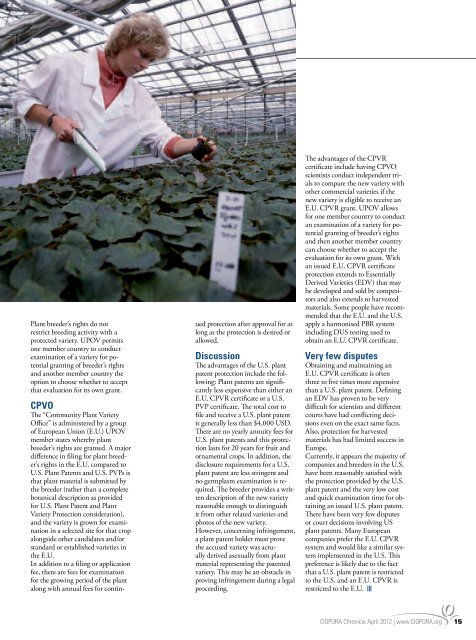2012 CIOPORA Chronicle
CIOPORA annual magazine on Intellectual Property protection for plant innovations 2012. The magazine was produced in cooperation with FloraCulture International. Read in the 2012 CIOPORA Chronicle edition: - Plant Patents in the United States after the America Invents Act - U.S. plant patents compared to UPOV PBR system - Does Belgian patent law need a breeder’s exemption? - How much open access can breeders afford? - IPP and PBR in Chile - IP protection for plant innovations in Canada and much more...
CIOPORA annual magazine on Intellectual Property protection for plant innovations 2012. The magazine was produced in cooperation with FloraCulture International.
Read in the 2012 CIOPORA Chronicle edition:
- Plant Patents in the United States after the America Invents Act
- U.S. plant patents compared to UPOV PBR system
- Does Belgian patent law need a breeder’s exemption?
- How much open access can breeders afford?
- IPP and PBR in Chile
- IP protection for plant innovations in Canada
and much more...
You also want an ePaper? Increase the reach of your titles
YUMPU automatically turns print PDFs into web optimized ePapers that Google loves.
Plant breeder’s rights do not<br />
restrict breeding activity with a<br />
protected variety. UPOV permits<br />
one member country to conduct<br />
examination of a variety for potential<br />
granting of breeder’s rights<br />
and another member country the<br />
option to choose whether to accept<br />
that evaluation for its own grant.<br />
CPVO<br />
The “Community Plant Variety<br />
Office” is administered by a group<br />
of European Union (E.U.) UPOV<br />
member states whereby plant<br />
breeder’s rights are granted. A major<br />
difference in filing for plant breeder’s<br />
rights in the E.U. compared to<br />
U.S. Plant Patents and U.S. PVPs is<br />
that plant material is submitted by<br />
the breeder (rather than a complete<br />
botanical description as provided<br />
for U.S. Plant Patent and Plant<br />
Variety Protection consideration),<br />
and the variety is grown for examination<br />
in a selected site for that crop<br />
alongside other candidates and/or<br />
standard or established varieties in<br />
the E.U.<br />
In addition to a filing or application<br />
fee, there are fees for examination<br />
for the growing period of the plant<br />
along with annual fees for continued<br />
protection after approval for as<br />
long as the protection is desired or<br />
allowed.<br />
Discussion<br />
The advantages of the U.S. plant<br />
patent protection include the following:<br />
Plant patents are significantly<br />
less expensive than either an<br />
E.U. CPVR certificate or a U.S.<br />
PVP certificate. The total cost to<br />
file and receive a U.S. plant patent<br />
is generally less than $4,000 USD.<br />
There are no yearly annuity fees for<br />
U.S. plant patents and this protection<br />
lasts for 20 years for fruit and<br />
ornamental crops. In addition, the<br />
disclosure requirements for a U.S.<br />
plant patent are less stringent and<br />
no germplasm examination is required.<br />
The breeder provides a written<br />
description of the new variety<br />
reasonable enough to distinguish<br />
it from other related varieties and<br />
photos of the new variety.<br />
However, concerning infringement,<br />
a plant patent holder must prove<br />
the accused variety was actually<br />
derived asexually from plant<br />
material representing the patented<br />
variety. This may be an obstacle in<br />
proving infringement during a legal<br />
proceeding.<br />
The advantages of the CPVR<br />
certificate include having CPVO<br />
scientists conduct independent trials<br />
to compare the new variety with<br />
other commercial varieties if the<br />
new variety is eligible to receive an<br />
E.U. CPVR grant. UPOV allows<br />
for one member country to conduct<br />
an examination of a variety for potential<br />
granting of breeder’s rights<br />
and then another member country<br />
can choose whether to accept the<br />
evaluation for its own grant. With<br />
an issued E.U. CPVR certificate<br />
protection extends to Essentially<br />
Derived Varieties (EDV) that may<br />
be developed and sold by competitors<br />
and also extends to harvested<br />
materials. Some people have recommended<br />
that the E.U. and the U.S.<br />
apply a harmonised PBR system<br />
including DUS testing used to<br />
obtain an E.U. CPVR certificate.<br />
Very few disputes<br />
Obtaining and maintaining an<br />
E.U. CPVR certificate is often<br />
three to five times more expensive<br />
than a U.S. plant patent. Defining<br />
an EDV has proven to be very<br />
difficult for scientists and different<br />
courts have had conflicting decisions<br />
even on the exact same facts.<br />
Also, protection for harvested<br />
materials has had limited success in<br />
Europe.<br />
Currently, it appears the majority of<br />
companies and breeders in the U.S.<br />
have been reasonably satisfied with<br />
the protection provided by the U.S.<br />
plant patent and the very low cost<br />
and quick examination time for obtaining<br />
an issued U.S. plant patent.<br />
There have been very few disputes<br />
or court decisions involving US<br />
plant patents. Many European<br />
companies prefer the E.U. CPVR<br />
system and would like a similar system<br />
implemented in the U.S. This<br />
preference is likely due to the fact<br />
that a U.S. plant patent is restricted<br />
to the U.S. and an E.U. CPVR is<br />
restricted to the E.U. |||<br />
<strong>CIOPORA</strong> <strong>Chronicle</strong> April <strong>2012</strong> | www.<strong>CIOPORA</strong>.org 15









